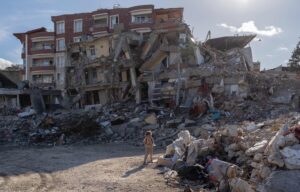
The living and the dead will soon be side by side on the outskirts of Antakya, where new government housing under construction to house the survivors of last year’s deadly earthquakes overlooks graveyards for those who perished.
“No one can bring back what was lost, as we lost everything,” said İsa Akbaba, who lost seven members of his extended family including his elder sister, Sıdıka, and his younger brother, Musa, during a visit to the cemetary.
Tuesday 6 February will mark a year since twin deadly earthquakes destroyed their homes in Turkey’s southernmost province, wrenching apart buildings as much of Antakya was destroyed. İsa’s mother, Suat Akbaba, was trapped under layers of debris for hours before she was eventually rescued.
Sıdıka and Musa were not so lucky. They are two among the 50,783 people estimated to have died in southern Turkey.
Turkish president Recep Tayyip Erdoğan travelled to the earthquake zone soon after the initial destruction, his sleek presidential sedan weaving among wreckage that many blamed on corruption within Turkey’s two-decade construction boom, a hallmark of his rule.
Erdoğan was quick to promise his citizens solutions to the damage, which spanned an area larger than the size of Belgium and the Netherlands combined and cost the country almost 10% of its GDP, according to a parliamentary inquiry.
“Our citizens should not worry. We will never allow for them to remain unsheltered,” he told the public during his visit to the quake zone, even as many, like the Akbabas, set up camp outside.
Erdoğan also promised reconstruction at breakneck speed, even as results appeared remote when towering piles of rubble covered swaths of the country.
“We will rebuild these buildings within one year and will hand them back to citizens,” he said, just four days after the earthquakes struck.
For months after the quakes, the grinding of machinery echoed across much of Turkey’s south-east, as workers tore down thousands of former homes and offices across the earthquake zone. Many, like the Akbabas, lived among the rubble. In other places, near the epicentre of the quakes – often those more closely associated with support for Erdoğan – government workers broke ground on new buildings a month after the earthquakes struck.
Because the Akbabas rented their former apartment, they will not be eligible for any of the 319,000 new homes that the president promised will be handed over to citizens.
Like many across Antakya, they are surveilling the empty lots that used to be their neighbourhood and waiting for private reconstruction, doubtful that they will be able to find somewhere they can afford to live amid a nationwide housing crisis and rising inflation.
The Akbabas have also grown used to mourning. Well into the summer months after the earthquake, they gathered next to the remains of their destroyed apartment block, grateful to be together as a family even as they lived among mounds of rubble and cement dust in a makeshift camp.
Local officials abruptly expelled them from the site in November, dispersing the family into container camps scattered around Antakya’s outskirts. The site of their former building is now a pit filled with construction equipment, ready to build a new apartment building that others could live in.
The Akbabas miss their former apartment, part of the daily suffering wrought by the earthquakes. “Our pain is still fresh,” said İsa.
